Death Valley National Park has plenty of colorful place names, including Furnace Creek, Stovepipe Wells, Last Chance Mountain, and Devil's Golf Course, so modern-day visitors might be understandably curious about the one given to one of the most popular scenic overlooks in the park: Zabriskie Point.
The explanation may be a bit surprising, since the name is tied to an activity not usually associated with national parks, and the story of the overlook itself offers a fascinating glimpse into the park's history.
This Scenic Viewpoint Predates The Park
The overlook was built nearly a century ago, not by the National Park Service, but by the Pacific Coast Borax Company. After so many years of use, it's now time for some serious repairs, and park officials announced this past week that all public access to Zabriskie Point and surrounding areas will be closed from October 1 through March 31, 2015, "for major rehabilitation work to the site. Contractors will be on site to repair unstable support walls and improve safety conditions. Currently, the walls are deteriorating to the extent that they pose a danger to public safety."
It's good to know those repairs are being made, but who was "Zabriskie"?
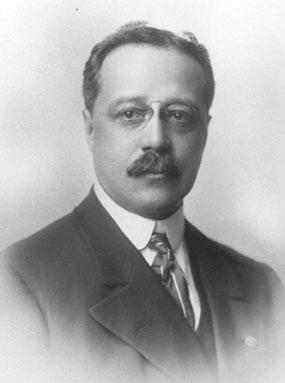
Christopher Zabriskie. NPS photo.
Christian Brevoort Zabriskie (1864'1936) was born at Fort Bridger, Wyoming Territory, and went to work at an early age as a telegrapher for the Virginia & Truckee Railroad at Carson City, Nevada. He then held a variety of jobs before he was hired by the Pacific Coast Borax Company.
Zabriskie ultimately became vice president and general manager of the company and served in that capacity for 36 years until his retirement in 1933. During this time, the Pacific Coast Borax Company had increased production in the Death Valley area.
That's an interesting career, but how did the name of this mining company official come to be attached to a scenic overlook in what's now one of America's largest national parks?
According to a park publication, the overlook that now bears his name was built by the Pacific Coast Borax Company in the late 1920s, "as a waystop to allow visitors in automobiles to see Manly Beacon, a prominent landmark in Death Valley's 'Badlands.'" The viewpoint is located east of Furnace Creek along the present-day Highway 190.
Park history buffs may recall that Death Valley's initial entry into the National Park System as a national monument didn't occur until 1933, so the plot thickens. Why did a borax mining company decide to construct an overlook for the convenience of tourists visiting the desert in the 1920s?
"20 Mule Team Borax" Became A Household Name
Part of the answer is found in a very successful advertising campaign launched in the 1890s for one of the company's household laundry products: "20 Mule Team Borax." The product became a household name in this country, and one historical account says the successful ad campaign "generated international publicity for Death Valley and hastened the development of tourism."
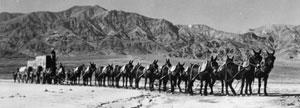
Twenty-mule teams were actually used at Death Valley for six years in the 1880s. NPS photo.
That 20 Mule Team brand was based on the actual use of "big teams" of mules to pull massive wagons hauling borax from the Harmony Borax Works near Furnace Creek to the railhead near Mojave. The grueling 165-mile trip across primitive roads took ten days, and the teams were used for only for six years'from 1883 to 1889'but they made an enduring impression on the minds of generations of Americans.
Just how successful was the "20 Mule Team" brand? Its products are still being sold, over 120 years later, and it spawned a radio show, Death Valley Days, that began in the 1930s. The show moved to television in 1952, and ran for 23 years! Ronald Reagan's last professional work as an actor before entering politics was on this show. The clip below includes an early episode of the TV show, featuring a character called 'The Old Ranger,' played by Stanley Andrews.
Visitors attracted to Death Valley by the earlier ads began camping at the borax company's developed property at Greenland Ranch, a forerunner of their more upscale development still known as Furnace Creek Ranch. The company also transformed the old mining town of Ryan into a hotel and used its rail lines to provide tourists with scenic rides overlooking the desert floor.
An excerpt from a park publication continues the story:
Could a Luxury Inn Save a Railroad?
"The Furnace Creek Inn was built by the Pacific Coast Borax Company of Twenty Mule Team fame as a means to save their newly built Death Valley Railroad. Mines had closed and shipping transportation was no longer needed, but mining tourist pockets seemed a sure way to keep the narrow-gauge line active. The borax company realized travelers by train would need a place to stay and wealthy visitors accustomed to comfort would be attracted to a luxury hotel."
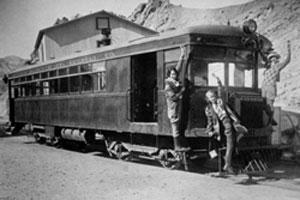
Death Valley Railroad's Brill car carried passengers between Death Valley Junction and Ryan, California. NPS photo.
"First opened for business in 1927, the Furnace Creek Inn was an immediate success. Unfortunately for the mining company, their railroad closed forever in 1930 when it became apparent tourists preferred the freedom of arriving in Death Valley in their own cars. Nonetheless, the Inn remained popular [with tourists.]"
The Lure of the National Park "Brand"
There's been quite a bit of talk in recent years about the value of the National Park "brand" in terms of attracting visitors'and their dollars'to an area. Attach the "national park" label to a local attraction, so the thinking goes, and the tourists will follow. It's the national park version of "If you name it, they will come."
The story of the Furnace Creek Inn and the present-day Death Valley National Park confirms that this idea was already alive and well nearly 90 years ago.
"Even with amenities such as a warm spring-fed swimming pool, tennis courts and nearby golf course, the Borax Company realized the primary attraction for their resort was its location in Death Valley," the park history continues. "An oasis of comfort and luxury in a wild and desolate desert proved to be irresistible to tourists."
Officials of the mining company realized tourists were being attracted to their resort at Furnace Creek by the combination of the rugged desert scenery and the "western lore" surrounding the 20 Mule Team brand'they weren't coming to see a mining operation.
Making Death Valley a "Must See"
"The mining company understood Death Valley's rustic charms could be easily lost without some preservation," notes a park history. "National Park status for Death Valley would not only limit damage from [other] mining but also control excessive development (and competing hotels.) Tourists hesitant to visit such a morbid-sounding place as Death Valley would know that it must be worth visiting if it was included with the nation's other crown jewels like Yosemite, Yellowstone, and Grand Canyon. It would become a 'must see.'"
Promoting the idea of a national park in Death Valley was indeed an astute business move for the Pacific Coast Borax's fledgling tourist business, and perhaps the company believed they had a natural ally in Washington. His name was Stephen Mather.
Mather was the first director of the National Park Service, and the agency was still just a decade old when the company invited Mather and his assistant, Horace Albright, to visit Death Valley in 1926. Although Mather was reportedly impressed by the scenery and agreed it was of national park quality, he declined the request to help.
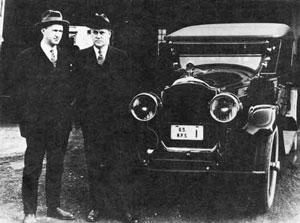
Stephen Mather and Horace Albright. NPS photo.
Years before becoming director, Mather and his father had both worked for Pacific Coast Borax; in yet another ironic convergence of events, Stephen Mather is often credited with the idea for the company's successful 20 Mule Team brand.
Mather left Pacific Coast Borax in 1904 to form his own company in the borax business and soon made a fortune; his wealth allowed the freedom to pursue other interests, including his eventual leadership role in the fledgling National Park Service.
Even though his ties with Pacific Coast Borax had ended a quarter-century earlier, Mather reportedly feared his support for the desert park could invoke claims of favoritism and perhaps even lead to a political scandal, so he declined to promote the idea.
Building Support for a National Park
As an alternative to his involvement, Mather suggested an alternative plan to promote a park'use of the media to spread the word about the wonders of Death Valley and build grass-roots support for protection of the area.
The resulting campaign included magazine and newspaper articles, but the national economic collapse that began in October 1929 added a major hurdle to the effort. Mather died in 1930, his assistant Horace Albright became the next NPS director, and Albright then felt free to promote the idea of a Death Valley National Park.
It was still a hard sell to Congress. The large number of mining claims in the area posed a problem for a park designation, and the idea that the stark desert terrain was actually "scenic" was a foreign concept for politicians who equated the term "national park" with places such as Yellowstone and Yosemite.
The solution was one which has also sparked considerable discussion in recent years: the use of presidential proclamations to establish national monuments. In February 1933, President Hoover did just that, and created Death Valley National Monument. It was one of the first desert areas in the National Park System, and was eventually designated a National Park by Congress in 1994.
The Park Idea Comes to Maturity
Since then, Death Valley National Park has grown to 3.4 million acres, and is one of the largest protected desert wilderness areas in America. The park is visited by nearly 1 million visitors a year who are drawn by the combination of desert wildlife, historic sites, colorful scenery, clear night skies, varied geologic features and the opportunity for solitude and adventure in this extreme desert environment.
A popular spot to enjoy that colorful scenery is still Zabriskie Point, and once the upcoming repairs to the overlook are completed next spring, it should be a favorite with visitors for years to come. During the time that viewpoint is closed, the park staff suggests you consider Golden Canyon, Artist's Drive, or Dante's View for other "exceptional vistas of the valley floor and distant peaks."
You'll find plenty of information to help plan a visit to Death Valley National Park at this link on the Traveler.

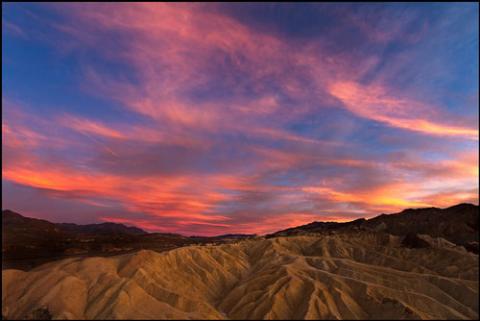
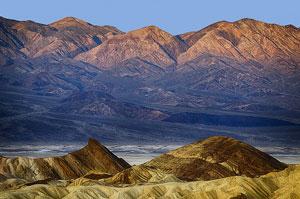


Comments
Fascinating. Thank you, Jim.
Thanks, Lee. I found the background for the overlook, and the park, to be really interesting once I started researching the story.
Yeah, Jim. But isn't that true about almost any subject? I want to try to get back to DEVA perhaps in February or so. It's an incredible place.
Did I miss it or did you actually state by who and when the site was given the name of Zabriskie Point?
Good question, and I didn't say :-) Sources I found didn't say either, but since the viewpoint predates the park, it seems likely the name was assigned by the company that built the viewpoint: Pacific Coast Borax, and the park just continued to use that previously established name. No real reason that I can see for the NPS to assign that name to the site after the area became a park.
Great article! I'm going to have to put this place on my bucket list.